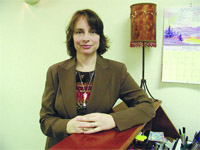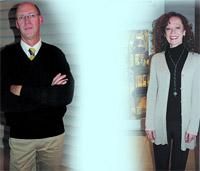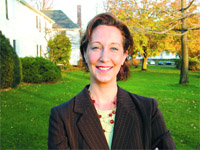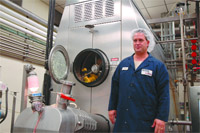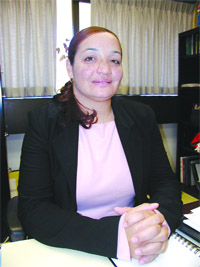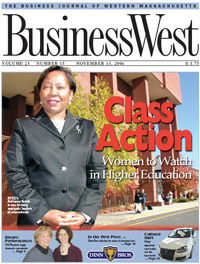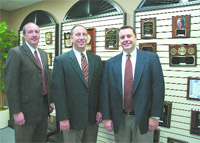Lauren Way remembers her early days as a young entrepreneur as a wild, intense learning experience.
She was in her early 20s and had just founded an international commodities trade company in the former Soviet Union, after majoring in Russian Civilization at Smith College. She said she expected the experience to be eye-opening and life-changing to a degree, but never expected to find herself embroiled in one of the most notable shifts of power and culture in history, as the Soviet Union dissolved and was replaced, by no means smoothly, by a Democratic, free-trade society.
Theese were times of flux and of famine, she said, recalling days watching tanks roll by while waiting in long lines, clutching ration tickets, for the only available food. Sometimes it was eggs, sometimes it was bread, but it was always scarce.
Today, Way is a professor and director of the entrepreneurial program and cooperative education initiatives at Bay Path College, and, though the road from Russia to Western Mass. was long and winding, she says those early experiences in a volatile setting played a large role in her decision to continue studying entrepreneurship and innovation, and, in turn, bring that knowledge with her to the world of academia.
Budding Abroad
This wasn’t a career path she’d planned, but one she has since embraced as an apt result of a diverse educational and professional background.
Way’s first entrepreneurial venture, as she sees it, was actually academic in nature; as a high school student in Chester, Vt., she researched private schools, applied for scholarships, and, after finishing most of the necessary leg work for admission and financing on her own, presented her parents with a proposal to attend Kimball Union Academy in New Hampshire.
“It was my first entrepreneurial approach to anything,” she said. “I was progressive about my own education, and that led to new opportunities, in addition to surprising my parents.”
Way did the same when researching colleges, and while at Smith, continued to follow her own unique path, selecting a major that few business owners have on their resume.
“I chose Russian Civilization because I love the language,” she explained, “and they say to major in what you love.”
The course of study led her to take her junior year (1990 to 1991) abroad through the American Collegiate Consortium International Exchange, during some of Eastern Europe’s most turbulent times. While honing her Russian language skills, Way also received a crash course in the ways of survival in a country undergoing a revolution. She quickly learned that nothing was free, and everything was hard to find, from luxury items to the most basic of necessities.
“That was definitely the most malnourished year of my life,” she said, adding, however, that her affinity for Russian culture only grew during her time in that country, and though she completed her study abroad and returned to the states to finish college, she soon went back to Russia to start a business with four Russian partners in 1992, importing everything from cooking pots to Portuguese wine.
It was an experience, she said, that offered a magnified view of the challenges associated with entrepreneurship and international business.
“We were really just testing the idea, pushing the buttons to see if we could make this work,” she said. “It was profitable, but the entire country was in flux. The value of rubles would change, drastically, literally overnight, and new laws were drafted from day to day and we had to interpret and reinterpret them.”
That shipment of Portuguese wine, for instance, weighed in at 20 metric tons and had the makings of being one of Way’s most promising imports, until while still in transit the import tax skyrocketed by 15%. Still, the venture proved to be an overall success, and a defining experience in Way’s life.
“At the time, I didn’t know if I had it in me, and conversely there were moments when I thought of myself as a failure because the business didn’t make me an amazing millionaire,” she said. “But I learned so much about entrepreneurship and about what I was capable of, and that’s an important idea to learn, and instill in others.”
From East to West
Way remained involved with the trade company for two years before selling her portion of the business to her partners and moving on to work with the international law firm White and Case as a paralegal in Moscow, continuing to interpret those complex laws in the new Russia. That four-year chapter in her career, as she calls it, also led to fluency in the Russian language and a solid understanding of the business climate in that country, as well the international scene.
However, like most entrepreneurs, Way was soon on the lookout for a new venture.
“I returned to the U.S. in hopes of finding something where the bottom line wasn’t money, but people,” she said, noting that she embarked on a series of meetings with other entrepreneurs in a sort of independent fact-finding mission, gleaning information on new opportunities, business practices that worked, and the individual strengths and histories of other successful business innovators. For a time, Way made ends meet with a succession of odd jobs, among them tending bar and serving as an interpreter at the 1996 Olympics in Atlanta.
Repeatedly, though, Way said she was attracted to academia, and the notion of developing her own entrepreneurial spirit and that of others on a formal level. She returned to Western Mass. — in part to take advantage of the vibrant college presence and also to enjoy the pace of life she experienced as an undergrad — and completed work toward a master’s in education at UMass Amherst. Soon after, in 1998, she took a post at Hampshire College as associate director of the Lemelson Assistive Technology Development Center.
“I wanted to be doing something that made me feel like I was making a meaningful difference,” she said, “and higher education is a field that I knew would allow for a wide-ranging approach to my career — one that would allow me to be a generalist, share my strengths, and also learn about several different things.”
Pioneers and Pathways
Way, who is now working toward a doctorate in Education focused on policy and leadership studies at UMass, remained at Hampshire College for eight years, managing an invention, innovation, and entrepreneurship program, developing curriculum, co-teaching a soft goods design course, and advising students on intellectual property and entrepreneurial business ventures. She joined Bay Path earlier this year, and describes her new position as a hybrid, one that couples theory-based teaching with practical program planning and the development of a broad, entrepreneurial focus at the college across all disciplines and departments.
“I think the college was looking for a specific type of person, one with a background in entrepreneurship as well as higher education,” she said. “The primary goal is to instill the entrepreneurial and innovative way of thinking, and programs leading to that on campus have grown so quickly that, in effect, we are academic entrepreneurs.”
Way added that while entrepreneurship is more often seen as an innate skill that, further, is only applied in the business world, she sees higher education as a perfect climate for fostering those entrepreneurial skills. She also sees the development of such programs at the collegiate level as necessary in a world that is increasingly homogenized, and in need of new, innovative solutions to issues both large and small.
“Teaching entrepreneurship is very multi-faceted,” she said. “If you just look at it from a business standpoint, you’re missing out. Practical knowledge can be augmented with theory, and I think it’s also false that creativity cannot be taught. I think it can be taught, or at least unleashed, in all types of students.”
Thus, it’s not just the creation of new businesses or products that Way hopes to see result from Bay Path’s entrepreneurial programming. Rather, it’s a more all-encompassing, entrepreneurial mindset, which can be applied to myriad situations — be they new business ventures, existing positions, or career paths.
“I’d like to see students take a more entrepreneurial approach to their careers and their lives in general, to latch on to that entrepreneurial way of thinking and to look at it as a process,” she said. “It’s increasingly necessary in order for people to propel themselves forward, and there is real value associated with the process.”
To that end, Way is in the midst of several initiatives at Bay Path designed to strengthen the entrepreneurial spirit on campus and, in turn, create a destination for women around the world in search of a cohesive, business-based education that will couple academic theory with tangible opportunities.
“My vision is that women will be able to come here with a business idea and graduate with that business up and running,” she said. “Making connections, marketing, accounting, public relations … these are all things that students can learn while in school, and in turn apply in real-life situations. Through this model, they can often do both at the same time. ”
Entrepreneurial programming is still a work in progress at Bay Path, but Way is a large part of its move forward. Already, students are working with local companies to solve actual business challenges, such as those associated with an expansion or change in product line, and are taking part in ‘live case studies’ involving those companies and the success of the new initiatives employed. Way will play a key role in writing grant proposals and helping the college secure additional funding for such initiatives as well, such as a three-year, $143,000 grant the Coleman Foundation awarded the college in 2005.
Students are also now taking part in a cooperative education program similar to an internship.
“It’s different from an internship in that it connects theory with practice in a way that internships often don’t,” said Way, and that’s where the bulk of her efforts lie in her new position — making connections between what is possible and how to apply that in a real-life setting.
The Next Line of Defense
That’s also a goal she plans to benefit from herself. Despite her varied history, Way said she has found a haven in higher education in which she intends to stay. Her goals for the future include advancing into higher-level administrative positions in education, perhaps even a college presidency in later years.
“I definitely see myself going deeper into the academic world,” she said. “I take a holistic approach to my job, and it’s exhilarating to see students doing the same, using a wide-ranging approach to entrepreneurship and to business, making meaningful contributions, and testing their own limits.”
And while it’s not likely that students at Bay Path will have to stand in long lines for bread or milk to test those limits, Way doesn’t see her experiences as very different from those that entrepreneurs, in all senses of the word, will face when meeting adversity head on.
“I learned so much about entrepreneurship while living in a country where it was often necessary to survive,” she said, “and that’s a good parallel for what I’m encouraging students to do here.
“They might not know if they have it in them, and to realize that they do, what is most important is the experience of doing.”
Jaclyn Stevenson can be reached at[email protected]









